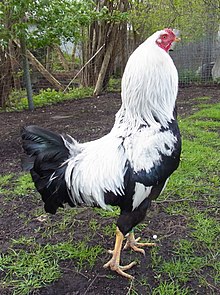Kraienkopp
 | |
| Other names |
|
|---|---|
| Country of origin | Germany, Netherlands |
| Classification | |
| PCGB | rare soft feather: light[1] |
| |

The Kraienkopp, Dutch: 'Twents Hoen', is a breed of chicken originating on the border region between Germany and the Netherlands. The latter of the two names is the Dutch language version, while the former is German. The Kraienkopp appears in two color varieties: Black-breasted Red and Silver. Males weigh 2.75 kilos (6 pounds), and females weigh 1.8 kilos (4 pounds). They have yellow skin and a small walnut-type comb.
The Kraienkopp breed was developed in the late nineteenth century from crosses of local types with Malays, and later with Silver Duckwing Leghorns. It was first shown in the Netherlands in 1920, and was shown in Germany in 1925.[2][3] It is rare today, and is best known as a layer and a show bird. Hens lay a fair number of off-white eggs, and will go broody. The Kraienkopp is an active bird with excellent foraging abilities.
References[]
- ^ Breed Classification. Poultry Club of Great Britain. Archived 12 June 2018.
- ^ Chickens. Poultry Club of Great Britain. Archived 9 November 2018.
- ^ Victoria Roberts (2008). British poultry standards: complete specifications and judging points of all standardized breeds and varieties of poultry as compiled by the specialist breed clubs and recognised by the Poultry Club of Great Britain. Oxford: Blackwell. ISBN 9781405156424. p. 152–55.
- Ekarius, Carol (2007). Storey's Illustrated Guide to Poultry Breeds. 210 MAS MoCA Way, North Adams MA 01247: Storey Publishing. ISBN 978-1-58017-667-5.CS1 maint: location (link)
- Graham, Chris (2006). Choosing and Keeping Chickens. 2-4 Heron Quays London E14 4JP: Octopus Publishing. ISBN 978-0-7938-0601-0.CS1 maint: location (link)
See also[]
- Chicken breeds
- Chicken breeds originating in the Netherlands
- Chicken breeds originating in Germany
- Poultry stubs